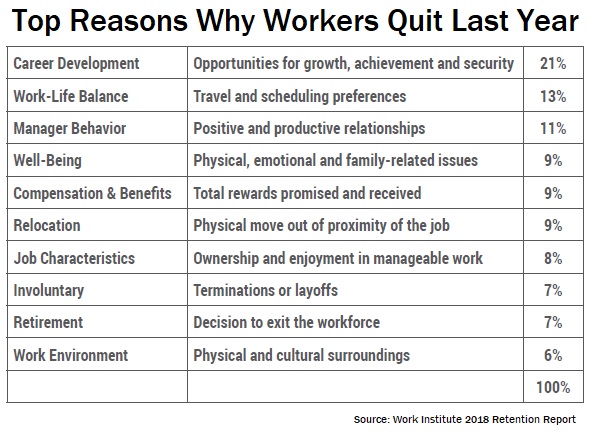Comprised of four or even five generations, today’s workforce is a melting pot made up of employees of all ages and demographics. It’s more diverse than ever, and as a result, can pose challenges for HR professionals and employers when determining compensation processes that meet the needs of the business first, but also employees.
Whether it’s baby boomers saving for retirement, Gen Z’s paying off student loans, millennials saving to buy a home and more, today’s generationally-diverse workforce has varying lifestyle and financial priorities. As such, businesses must reimagine pay and benefits in ways that were not seen in previous generations.
However, when it comes to rethinking compensation and benefits to recruit and retain top talent, employers must understand that compensation is not synonymous with salary. In fact, a recent report by the Work Institute shows that while compensation and benefits (9%) are among the top reasons employees leave a company, other reasons like retirement (7%), well-being (9%) and work-life balance (13%) are also critical factors that employers should consider when developing their compensation packages.
In other words, pay alone isn’t enough to make employees across all ages feel valued or incentivize them to stay at your company. For employers looking to reimagine pay for today’s multi-generational workforce, here are two things to keep in mind.
Workers motivated by pay transparency
As today’s companies continue to face scrutiny for steep CEO-to-worker wage gaps and dated approaches to compensating across genders, employees of all ages can agree on pay equality and pay transparency. In fact, a Glassdoor report shows that 70% of employees globally believe salary transparency is good for employee satisfaction, and 72% believe it’s good for business.
Pay transparency isn’t just good for business, it’s motivating for employees. A new report by the National Bureau of Economic Research reveals that employees will work harder when they find out their bosses make more money than they expected. Effort decreases if they know or even believe their peers earn more. As the authors note, “While higher perceived peer salary decreases effort, output, and retention, higher perceived manager salary has a positive effect on those same outcomes.”
While discussing and sharing pay among peers was once a taboo topic, it’s now commonplace and actually good for long-term productivity, motivation, engagement, loyalty and more — all of which means employers must find ways to provide greater pay transparency.
Luckily, via artificial intelligence, predictive analytics and automation, businesses can take the guesswork (and unconscious bias) out of creating fair and transparent compensation plans for employees. Through the application of new technologies, businesses can ensure greater pay transparency by:
- Helping employees understand why they are being paid the salary they are, and how their performance ties back to overall organizational goals.
- Showing how compensation is optimized and personalized to meet individual an employee needs – i.e. how alternative pay options can be tied to performance.
- Proving salary is based on factors that actually contribute to worker performance (education, experience, certifications, etc.) and not on discriminatory factors like age, race and gender.
Reimagining pay starts with leveling the pay playing field for all of employees. By using employee compensation and performance data, businesses can begin to provide greater pay transparency and eliminate generational challenges, such as workplace diversity and pay equity.
Nontraditional compensation
An organization’s willingness to explore personalized, nontraditional compensation offerings, such as remote work policies, spot bonuses, digital currency offerings and more, affects its ability to recruit and retain talent, especially young talent. Millennials, who now make up more than one-third of the American workforce, expect “more” from the companies that employ them – including performance recognition (whether it’s in the form of bonuses, non-cash prizes, salary increases), pay equity and flexibility.
In fact, a new report identifies flexibility as a key factor in determining employee satisfaction with 85% of office professionals saying it’s of utmost importance to them. Not only that, flexibility is also a leading factor for recruiting and retention with 73% of the responding office staff saying a flexible schedule is in their top two reasons for staying with a company, and the number one thing workers cited when asked what they expect from their next employer (58%). While flexibility and remote work options certainly appeal to millennials and Gen Zs, it’s something all generations of the workforce are demanding. Whether it’s a new parent who needs flex time to pick their child up from daycare, or an employee nearing retirement who wants to spend less time fighting traffic to come into the office every day, flexible work benefits go a long way to improve employee morale and loyalty.
Additionally, when it comes to personalized compensation beyond pay, spot or cash bonuses can be a fun way to gamify performance and incentivize employees, while also adding some friendly competition to the mix. New advancements in technology are also making digital currencies, such as bitcoin, an attractive option for companies to incorporate into compensation plans. While still at the early stages of adoption, companies are beginning to explore providing bitcoin benefits and payment to employees.
When reimagining compensation and benefits to recruit and retain today’s diverse workforce it’s important for organizations to think beyond traditional means and more about providing the benefits, perks, transparency and fairness that have broad appeal. With the help of technology and the data that’s produced as a result, organizations are better positioned to make decisions that the multi-generational workforce values.
